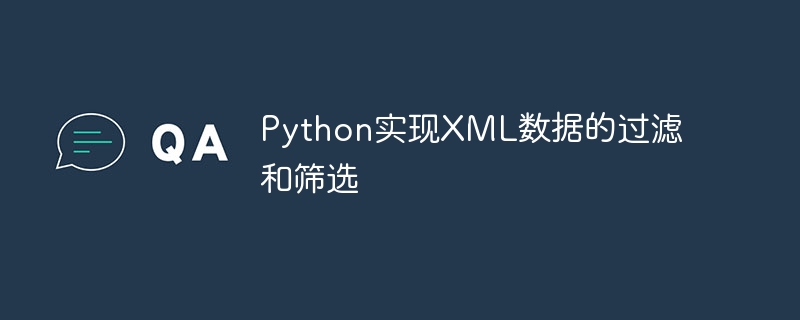

Python implements filtering and filtering of XML data
XML (eXtensible Markup Language) is a markup language used to store and transmit data. It has flexibility and Scalability, often used for data exchange between different systems. When processing XML data, we often need to filter and filter it to extract the information we need. This article will introduce how to use Python to filter and filter XML data.
Before we begin, we need to import the required modules. In Python, we can use the xml.etree.ElementTree module to process XML data.
import xml.etree.ElementTree as ET
To process XML data, you first need to parse the XML file into a tree structure. We can use ElementTree's parse function to achieve this.
tree = ET.parse('data.xml') # 解析XML文件
root = tree.getroot() # 获取根节点Assume here that we have an XML file named "data.xml". We use the parse function to parse it into a tree structure and obtain the root node through the getroot function.
If we only care about the data of some specific tags, we can filter out the tags we are interested in by traversing the XML tree. The following is an example, we assume that we want to extract all tags named "item":
items = root.findall('item') # 过滤出所有名为"item"的标签
for item in items:
# 处理item标签的数据
passUse the findall function to filter out all tags named "item" and store them in a list. Then, we can iterate through the list and process the data of each item tag.
In addition to filtering tags, sometimes we also need to filter out specific data based on the value of the attribute. The following is an example. We assume that we want to extract the "item" tag with the attribute "type1":
items = root.findall('item[@type="type1"]') # 筛选出属性为"type1"的item标签
for item in items:
# 处理item标签的数据
passUsing XPath expressions in the findall function can filter out specific tags based on the value of the attribute. In this example, we use [@type="type1"] to specify the filter criteria.
If we only care about the text content of the label, we can use the text attribute of Element to get it. The following is an example, we assume that we want to extract the text content of all "item" tags:
items = root.findall('item') # 过滤出所有名为"item"的标签
for item in items:
text = item.text # 获取标签的文本内容
# 处理文本内容By accessing the text property of Element, we can obtain the text content of the label and process it.
The above is the basic method of using Python to filter and filter XML data. By parsing XML files, filtering tags and attributes, and obtaining the text content of tags, we can extract specific information from XML data as needed. I hope this article can be helpful to readers who use Python to process XML data.
References:
The above is the detailed content of Python implements XML data filtering and filtering. For more information, please follow other related articles on the PHP Chinese website!




